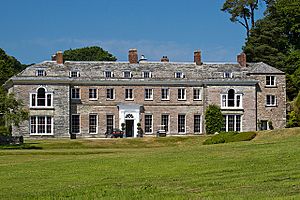Boconnoc facts for kids
Quick facts for kids Boconnoc
|
|
|---|---|
| Lua error in Module:Location_map at line 530: Unable to find the specified location map definition: "Module:Location map/data/Cornwall (mainland)" does not exist. | |
| Population | 122 (Parish, 2011) |
| OS grid reference | SX147607 |
| Unitary authority | |
| Ceremonial county | |
| Region | |
| Country | England |
| Sovereign state | United Kingdom |
| Post town | LOSTWITHIEL |
| Postcode district | PL22 |
| Dialling code | 01503 |
| Police | Devon and Cornwall |
| Fire | Cornwall |
| Ambulance | South Western |
| EU Parliament | South West England |
| UK Parliament |
|
Boconnoc (which means Boskennek in Cornish) is a small civil parish in Cornwall, England. It's about four miles east of the town of Lostwithiel. In 2011, about 96 people lived here.
Boconnoc is a very rural area with lots of trees. It shares borders with several other parishes like St Winnow and Lanreath. You can find small communities like Couch's Mill and Brooks within the parish. A special part of the old deer park at Boconnoc House is super important for lichens. It's one of the best places in Europe to find these tiny plant-like organisms!
Contents
Discovering Boconnoc's Past
Boconnoc has a long and interesting history. You can find old Cornish crosses in the churchyard, on Druids' Hill, and in Boconnoc Park. One cross in the park was moved from another place called Lanlivery and has cool carvings on it.
Boconnoc was first mentioned in a very old book called the Domesday Book in 1086. It was called Bochenod back then. The first known owners of the land were the De Cant family in 1268.
Who Lived at Boconnoc House?
The current Boconnoc House was built where an even older house once stood. This old house belonged to families like the Carminows and Mohuns. Later, the estate was sold to Governor Thomas "Diamond" Pitt. He was a very rich trader who made a lot of money in India.
Governor Pitt started a famous family! His grandson, William Pitt the Elder, and his great-grandson, William Pitt the Younger, both became important politicians in England. After Governor Pitt passed away in 1726, the estate stayed in his family for many years. In 1873, a man named Mr. Cyril Fortescue owned Boconnoc. He was one of the biggest landowners in Cornwall at the time.
Boconnoc's Role in Modern Times
The Boconnoc estate is full of history and has the largest designed park in Cornwall. It's also home to the Boconnoc Cricket Club, which plays in the beautiful Deer Park.
Did you know Boconnoc was even used in a movie? In 1993, parts of the estate were used to film The Three Musketeers!
A small chapel once stood in the hamlet of Trecangate from 1820 to 1954. It was built with cob walls, which is a mix of clay, sand, straw, and water. In 2009, a sign was put up to mark where it used to be.
Exploring Boconnoc House and Estate
Boconnoc House is a special old building, listed as Grade II*. It was built in the 1700s by members of the Pitt family. One part was built around 1721 by Thomas Pitt, who was a Governor in India. Another part was added in 1772 by Thomas Pitt, 1st Baron Camelford. The two parts formed an L-shape.
The gardens around the house are beautifully designed. On a hill behind the house, there's a tall stone monument called an obelisk. It was built in memory of Sir Richard Lyttelton in 1771. In the 1800s, the Fortescue family took over the estate and made some changes to the house in 1883.
The Parish Church at Boconnoc
The local church is located right behind Boconnoc House. It's quite small, and we don't know for sure which saint it's dedicated to. Inside, you can find an interesting font from the 1400s. There's also a monument dedicated to Penelope Mohun from 1637.
The church's tower is quite unique, with five sides at the bottom and eight at the top. Other cool things to see include a special gallery where musicians used to play, the altar table made in 1621, and an old wooden pulpit.
Nature and Wildlife at Boconnoc
The Boconnoc estate surrounds the River Lerryn. It includes a deer park, a lake, farmland, and lots of woodland. Parts of the estate are protected areas because they are so important for nature. These areas are called Boconnoc Park Important Plant Area and Boconnoc Park & Woods Site of Special Scientific Interest. They are known for their amazing plants and animals.
Wildlife and Ecology
Very old, sessile oak trees grow in the valleys and on the slopes of the ancient deer park at Boconnoc House. These trees are home to a huge variety of lichens, making it one of the most important places in Europe for these organisms. This site is also considered the best "old-growth, southern-oceanic oak woodland" in the south-west of England.
Images for kids



